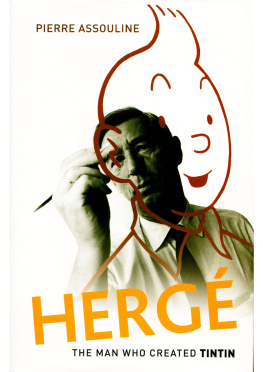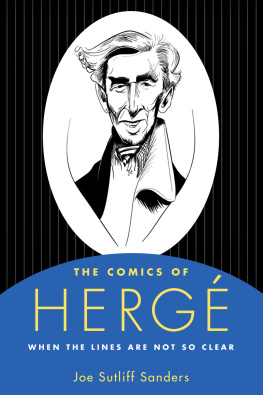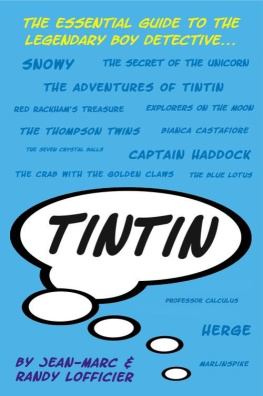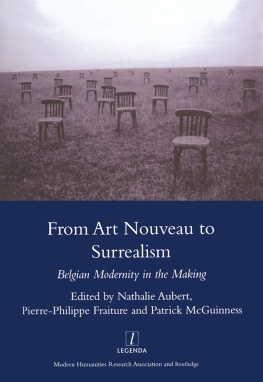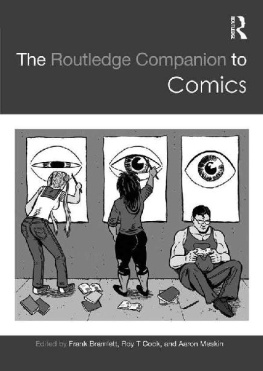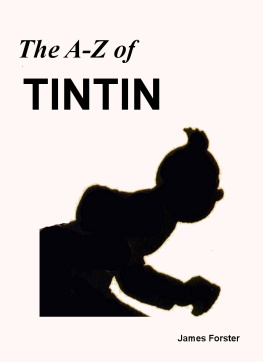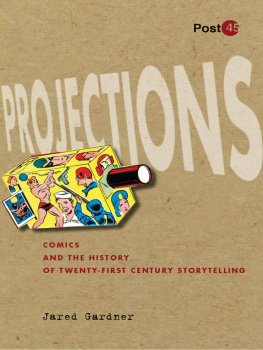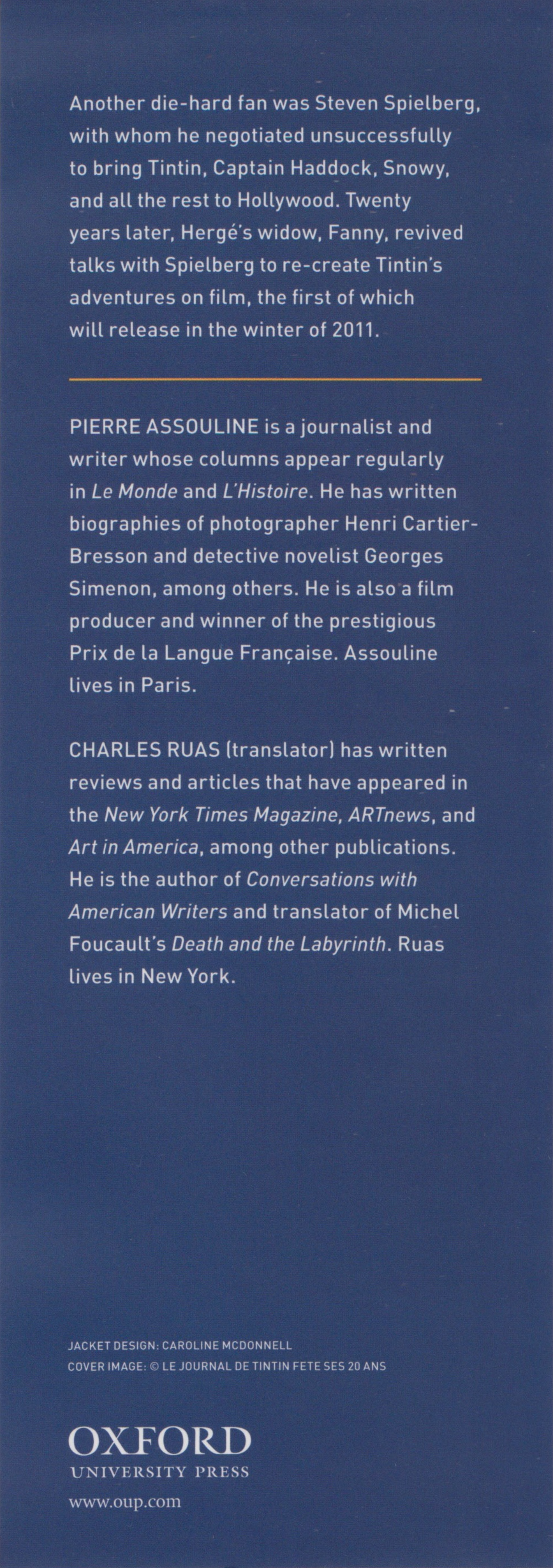
Herge THE MAN WHO CREATED TINTIN
Pierre Assouline
This book was produced in EPUB format by the Internet Archive.
The book pages were scanned and converted to EPUB format automatically. This process relies on optical character recognition, and is somewhat susceptible to errors. The book may not offer the correct reading sequence, and there may be weird characters, non-words, and incorrect guesses at structure. Some page numbers and headers or footers may remain from the scanned page. The process which identifies images might have found stray marks on the page which are not actually images from the book. The hidden page numbering which may be available to your ereader corresponds to the numbered pages in the print edition, but is not an exact match; page numbers will increment at the same rate as the corresponding print edition, but we may have started numbering before the print book's visible page numbers. The Internet Archive is working to improve the scanning process and resulting books, but in the meantime, we hope that this book will be useful to you.
The Internet Archive was founded in 1996 to build an Internet library and to promote universal access to all knowledge. The Archive's purposes include offering permanent access for researchers, historians, scholars, people with disabilities, and the general public to historical collections that exist in digital format. The Internet Archive includes texts, audio, moving images, and software as well as archived web pages, and provides specialized services for information access for the blind and other persons with disabilities.
Created with abbyy2epub (v.1.7.6)
PIERRE ASSOULINE
THE MAN WHO CREATED TINTIN
Another die-hard fan was Steven Spielberg, with whom he negotiated unsuccessfully to bring Tintin, Captain Haddock, Snowy, and all the rest to Hollywood. Twenty years later, Herge's widow, Fanny, revived talks with Spielberg to re-create Tintins adventures on film, the first of which will release in the winter of 2011.
PIERRE ASSOULINE is a journalist and writer whose columns appear regularly in Le Monde and L'Histoire. He has written biographies of photographer Henri CartierBresson and detective novelist Georges Simenon, among others. He is also a film producer and winner of the prestigious Prix de la Langue Francaise. Assouline lives in Paris.
CHARLES RUAS (translator) has written reviews and articles that have appeared in the New York Times Magazine, ARTnews, and Art in America, among other publications.
He is the author of Conversations with American Writers and translator of Michel Foucaults Death and the Labyrinth. Ruas lives in New York.
JACKET DESIGN: CAROLINE MCDONNELL
COVER IMAGE: LE JOURNAL DE TINTIN FETE SES 20 ANS
OXFORD
UNIVERSITY PRESS
www.oup.com
OXFORD
UNIVERSITY PRESS
Oxford University Press, Inc., publishes works that further Oxford Universitys objective of excellence in research, scholarship, and education.
Oxford New York
Auckland Cape Town Dar es Salaam Hong Kong Karachi Kuala Lumpur Madrid Melbourne Mexico City Nairobi New Delhi Shanghai Taipei Toronto
With offices in
Argentina Austria Brazil Chile Czech Republic France Greece Guatemala Hungary Italy Japan Poland Portugal Singapore South Korea Switzerland Thailand Turkey Ukraine Vietnam
Pierre Assouline s text copyright 1996 by Pierre Assouline and PLON Originally published in France under the tide Hergi
Translation copyright 2009 by Charles Ruas
Published by Oxford University Press, Inc.
198 Madison Avenue, New York, NY 10016
www.oup.com
Oxford is a registered trademark of Oxford University Press
All rights reserved. No part of this publication may be reproduced, stored in a retrieval system, or transmitted, in any form or by any means, electronic, mechanical, photocopying, recording, or otherwise, without the prior permission of Oxford University Press.
Library of Congress Cataloging-in-Publication Data Assouline, Pierre.
Herg6: the man who created Tintin / Pierre Assouline; translated by Charles Ruas. p. cm.
This first English-language edition retains the core but not the totality of the original French edition.
Includes bibliographical references and index.
ISBN 978-0-19-539759-8
1. Herg^, 1907-1983. 2. CartoonistsBelgiumBiography. I. Title.
PN6790.B43H47264 2009
741.5092dc22 [B] 2009022411
This first English-language edition retains the core but not the totality of the original French edition.
987654321
Printed in the United States of America on acid-free paper
To you three
What if I told you that I put my whole life into Tintin?
Herge, 1982
contents
preface ix
part i: truths
1. A Life in Gray: 1907-1925 3
2. Scoutmaster in the Twentieth Century: 1925-1929 11
3. The Many Births of Tintin: 1929-1934 19
4. What Chang Taught Herge: 1934-1936 48
5. Eye of the Storm: 1936-1940 54
6. The Golden Age: 1940-1944 69
part ii: solitude
7. The Plight of the Inciviques: 1944-1946 105
8. The Dark Years: 1946-1950 120
Vll
Vlll
CONTENTS
part m: recognition
9. Toward Fulfillment: 1950-1958 147
10. The Demon of Purity: 1958-1960 184
11. Finishing Touches: 1960-1973 193
12. The End of a Life, the Culmination of His Work: 1973-1983 207
abbreviations used in notes 235
notes 236 select bibliography 256 list of works by herge 259 acknowledgments 261
index 263
preface
Herg became so completely identified with Tintin that whenever he arrived at a reception it was as if Lewis Carroll were making an appearance at a childrens tea party. His easy serenity and friendly manner, the gende magnetism of his presence, made everyone forget that the character he created inhabited only a paper universe. I have to confess right at the start that until I began my research I was also guilty of this illusion, because, like so many others, my childhood and adolescence were conditioned by my passion for Tintin. It s still difficult to underestimate the impact of his work on several generations of Europeans. Countless numbers of people claim to be complete strangers to the world of comic strips and never read comic books, then add, Except for Tintin!
I first considered doing a biography of Georges Remi, alias Herge, as a result of a conversation with my friend Andre Versailles, an editor in Brussels, who managed to plant a serious doubt about the true nature of this creative genius.
Sometime later, after appearing on the television program about books called Bouillon de Culture, I was backstage talking with panelists and members of the audience over a glass of wine when guests from Wallonia French-speaking Belgiumsaid, You understand that Simenon and Herge are our two sacred monsters ... but if both are admired, Herge is also loved. Belgians would not stand for your treating Herge the way you did Simenon. I wondered why. The journalist in me suddenly became curious.
The following month at a book signing in Brussels a distinguishedlooking elderly gentleman handed over a book to be inscribed and said, May I suggest that you devote your next work to Herge? The subject is prodigiously interesting, and in portraying his life you would be telling the
story of Belgium in the twentieth century. And as Belgium is on the verge of disappearing, it would be timely.
Next page
